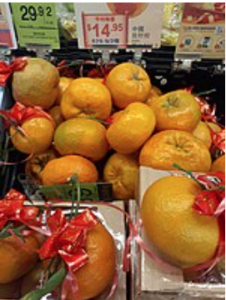
Now that the end of the year holidays are in the offing, curbing excessive fat has just become easier, thanks to tangerine, a citrus fruit that is in season between late Fall and early Spring time. Tangerine owes its name to Tangier, a Northwestern Moroccan city with close proximity to the Mediterranean Sea.

As a component of a breakfast meal or as a pre-meal by itself, tangerine can provide a significant amount of Vitamin C, fiber, and multiple other notable nutrients. The beneficial nutrients in tangerine assist in boosting energy while encouraging the stabilization of body weight, a process that prevents diabetes or helps manage the condition. When consumed in normal portions — with one portion being the equivalent of the size of one’s hand — the sugar content of tangerine does not represent a risk to individuals with blood sugar issues.

Fruit sugar by itself is not always a threat. What is a cause for concern mostly is what the sugar is combined with. When in combination with gluten-laden starch carbohydrates and fats, mainly animal fats, excessive fructose can generate health issues that may lead to an overweight body. Because of this, as a rule of thumb, tangerine as well as fruits of any kind, are best eaten alone if one does not know about or does not understand the food combination chart. A twenty-minute gap between the consumption of the fruit and other components of breakfast is a reasonable amount of time that allows digestion to take place while the beneficial nutrients from the fruit are being properly absorbed.

Nutrition Facts about Tangerine
Serving size: the amount that one’s hand can hold.
Vitamin A: 5-13.5% depending on breed (hybrid fruits contain fewer nutrients)
Vitamin C: 32%
Potassium: 4%
Calcium: 4%
Sugar: 9-10.50 gr
Dietary fiber: 1.5 gr
Carbohydrate: 12 gr
Fat: 0.5 gr
Calories: 47

It is not just the tangerine pulp that contributes to major health benefits. The peels of tangerine do contain tangeretin, an antioxidant also referred to as a super-flavonoid. Tangeretin greatly benefits the cardiovascular system, as it serves to drain excess ‘bad’ cholesterol out of the body. A lower amount of ‘bad’ cholesterol means less obesity, therefore a lesser risk of diabetes and blood sugar imbalances.

The health benefits of tangerine are not solely for the physical body. Science has proven that limonene, a chemical compound that is a constituent of the tangerine’s natural oils, is big medicine. Limonene from the tangerine’s zest is well known to contribute to natural mood upliftment and anxiety relief, at the same level as sunshine does. Besides limonene, tangerine harbors valuable bioflavonoids that are powerful anti-oxidant, therefore reduces free-radical damage. Many quantum therapists recommend adding well-washed tangerine peels to any type of tea one chooses to consume for health benefits or self-nurture.

As it is the caveat for all citrus fruits, tangerine has the ability to chelate bodily toxins as well as hydrate live cells. Besides its goodness, the sweetness of tangerine makes it a favorite fruit suitable for enjoyable consumption and also gift-giving at holiday time. This is an ideal way to encourage others to consume unprocessed fruits, a process that when developed into a habit eventually leads to a trimmer and more fit body.


Sri Regine Lherisson-Bey, Ph.D. and doctorate degree candidate in Natural Medicine, is a Mind-Body Therapist, Wellness Coach, and published Author voted Wellness Expert by peer consensus in 2005. Therapist Lherisson-Bey is the author of the Kindle bestseller HOW TO DETOXIFY YOUR LIFE NATURALLY as well as the weight management program GET SLIM EFFORTLESSLY. From an original CD, the publication has evolved into an instructional picture book, an eBook, and an effective weight management program. Therapist Lherisson-Bey’s works have been featured on TV, radio, and in several magazines in the past 32 years.

If you have found this article helpful and would like to send a donation as a gesture of appreciation, use the Donate button below:

Content Disclaimer: The information contained in this post may not be interpreted as medical advice. Read the full disclaimer here…![]()
Photography and Videography materials attribution:
pixabay.com
wikimedia.org
BarnesandNoble.com



